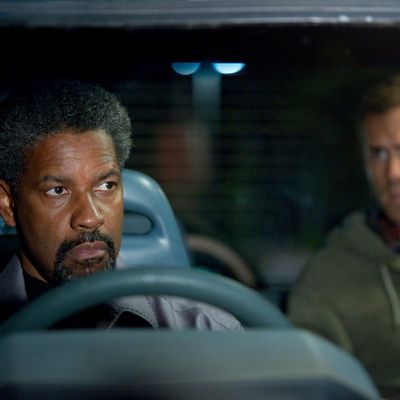
Denzel Washington co-produced and stars in the jangly, hyperslick espionage thriller Safe House, which is expertly fashioned to suit his most crowd-pleasing persona: the bad guy who’s so cool that he inspires you even as he poses a threat to the social order. Perhaps he inspires you because he poses a threat to the social order. Perhaps he’s bigger than the social order. He’s certainly less naïve about the supposed good guys, and a lot more candid about going after what he wants: the mother lode.
In Safe House, Washington plays Tobin Frost, a CIA agent who reportedly wrote the book on modern interrogations before becoming the company’s most notorious traitor. Wanted on four continents, he has no allegiances and no relationships outside work. Is there anything he loves? Yes: ’72 Petrus. With his favorite wines, he permits himself to sniff, sip, and, for a moment, get intimate. Then back to business.
As the movie opens, Frost is in South Africa selling especially incendiary intelligence when he’s set upon by unknown assassins, who are prodigious enough to compel him to take refuge at the nearby American consulate, where he knows, at least, he won’t be killed. Promptly arrested, he’s transported to a Cape Town safe house managed by junior agent (and “housesitter”) Matt Weston (Ryan Reynolds), who’s frustrated by his lack of opportunities for advancement. He’s about to get one. When the safe house is breached and everyone else wiped out, he finds himself on the lam with a handcuffed Frost.
By the middle of Safe House, I’d predicted every cross and double-cross to come but was goggle-eyed anyway. Director Daniel Espinosa is (despite that Spanish surname) a Swede who has obviously studied state-of-the-art Euro thrillers by Luc Besson and above all the Bourne pictures. He packs the film with jump-cuts and fist-fights in which the careening, handheld camera goes tight on the blows and counter-blows and glass- and furniture-smashing, with Reynolds getting blasted around the frame like a pinball. The movie is color-coordinated — fluorescent greens and blues and purples — down to the glossy, tutti-frutti storage units in a Cape Town stadium complex. In one rollicking car chase, Weston evades assorted bullet-spitting baddie vans while grappling with his passenger, who puts him in a choke hold that sends their car swerving all over the highway.
Safe House isn’t all crashed cars and dodged bullets: The quieter scenes have their own punch. (The script is by David Guggenheim.) Frost the infamous turncoat preys on the insecurities of Weston the company man, planting doubts about his superiors (they include Brendan Gleeson, Vera Farmiga, and Sam Shepard) and even his potential for a lasting relationship with his dishy French doctor girlfriend (Nora Arnezeder). What separates Safe House from the standard Cuisinart-cut action picture is that it’s marinated in post-Iraq cynicism, that the bad guy’s way of seeing the world is closer to how the world is than anyone giving the hero his orders. No, that doesn’t let Washington’s Frost off the hook: The film’s morality is too Hollywood-conventional for that. But in the end, he’s the only one of Weston’s mentors who matters. The title has a nice irony: The safe house is the least safe place on Earth.


